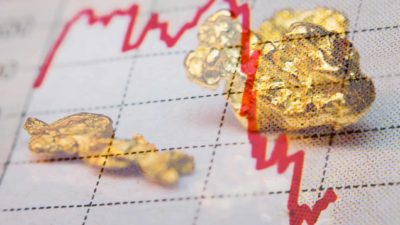Gold rush!
Much has been made of a certain metal of the yellow variety in recent times. That's to be expected when an asset hits an all-time high. Gold caused quite a stir late last month when it surged past its 2011 record high of US$1,921 an ounce.
After racing as high as US$2,075, the gold price has now settled back around US$1,950, where it has hovered for the past week or so. Other precious metals like platinum and silver (in particular) have also been shooting higher in recent weeks. So with upward momentum seemingly stalling for now, where to next for ASX gold bugs?
Why has the gold price hit the roof?
Gold is traditionally a 'risk-off' investment asset, which means investors usually flock to it when there are concerns over the immediate future of 'risk-on' investments like ASX shares.
So it is somewhat confusing to see gold hit record highs when global sharemarkets are concurrently rising. My reading on this phenomenon is that investors are not too bullish on the medium-to-long-term outlook for the share market in light of the coronavirus pandemic. Add to this concerns over future inflation stemming from the truckloads of central bank cash injections into the global financial system and we have a perfectly mixed cocktail for a rising gold price.
Can the gold price go higher?
Now that gold has reached past its 2011 peaks (and is up nearly 30% in 2020 so far), I'm sure most of you are wondering whether gold can really climb higher from here.
Well, there is one commentator that answers a resounding 'yes' to this question. Reporting from precious metals news site Kitco.com points out that, although the gold price has hit new all-time highs, it still remains well-below it's an inflation-adjusted all-time high. In fact, when you include the effects of inflation, gold has yet to even break it's 2011 high. Let alone the inflation-adjusted record that was set way back in 1980.
Kitco tells us that it's inflation-adjusted 2011 high is worth a price of US$2,149.69 an ounce today — a level not yet tested in 2020.
And if gold were at the same level today as 1980, adjusting for inflation, it would be commanding a price of US$2,722.18 an ounce. That's another 40% on top of the current gold price.
For silver, the potential is even better. Today, one ounce of silver will set an investor back US$26.80 an ounce. If silver was to re-test the 1980 inflation-adjusted peak, it would need to be trading at US$160.59 an ounce.
Foolish takeaway
Just because gold (or silver) prices could go higher from here doesn't necessarily mean they will. But personally, I am bullish on the medium-term outlook for precious metals, mostly due to the factors listed above. I think monetary debasement will come at a cost, and this cost could indeed see precious metal prices push higher in the years ahead. If you agree, you might want to invest with this in mind.








